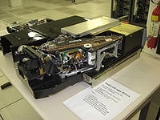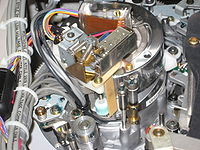
StorageTek tape formats
Encyclopedia
Storage Technology Corporation
, or StorageTek, has created several magnetic tape data storage
formats. These are commonly used with large computer systems, typically in conjunction with a robotic tape library
. The most recent format is the T10000. StorageTek has primarily competed with IBM
in this market, and it continues to do so after its acquisition by Sun Microsystems
in 2005 and again by Oracle
in 2009.
Nearly all 1/2" tape formats today are a single hub design, whereby the tape is wound onto a single hub, entirely within the external shell and presents one end for the tape drive to engage and thread into the tape drive for reading or writing. The mechanical design of this loading mechanism varies between different types of tape media and is a common source of failures. Usually the tape cartridge incorporates a switch that can be set to permit or forbid writing of data to the tape.
It is very common for the tape cartridge to be identified by an external label or sticker, which is normally both in human readable characters such as AB1023 and also in bar code, to be read by devices in an automated library.
At the end of the tape, the drive reversed the direction of tape motion, moved the read and write heads slightly vertically across the tape, and continued to write (or read) more data until the beginning of the tape was reached. This process could be repeated many times, laying down several track sets on the tape media in a serpentine recording mode. The Storage Tek 9840, 9940 and T10000 drives are all serpentine recording drives.
The Storage Tek SD3 drive was different, being based upon a modified video recording device. The tape advanced steadily, and data was recorded (or read) by a cylindrical head rotating at high speed and inclined at a small angle to the direction of tape motion, laying down (or reading back) a series of short data tracks very closely spaced together -- helical scan
.
The Storage Tek 9840 series of drives used a relatively unusual dual tape hub mechanism within the 3480 format shell, similar to the familiar audio tape format. This reduced the length of tape that could be stored inside the shell, and hence reduced the data capacity of the cartridge. However, it made the loading or threading of the tape into the drive very fast, which was useful in business applications - and the drive price was set to a very high in comparison to the contemporary LTO drive, despite having one fifth of its capacity.
These tape formats are popular in mainframe environments.
Drives used ESCON
, FICON
, Fibre Channel
, or SCSI
interfaces.


The drive was based on a professional Panasonic video recording system
, modified to be suitable for digital data recording. The result was a large, heavy drive of considerable complexity. Although somewhat difficult to maintain, it won popularity among some users due to the relatively low cost of the media per Gigabyte.
Storage Technology Corporation
Storage Technology Corporation , aka STC until about 1983, is a data storage technology company. Current StorageTek products focus on tape backup equipment and software to manage storage systems. New products include data retention systems, which they call information lifecycle management, or ILM....
, or StorageTek, has created several magnetic tape data storage
Magnetic tape data storage
Magnetic tape data storage uses digital recording on to magnetic tape to store digital information. Modern magnetic tape is most commonly packaged in cartridges and cassettes. The device that performs actual writing or reading of data is a tape drive...
formats. These are commonly used with large computer systems, typically in conjunction with a robotic tape library
Tape library
In computer storage, a tape library, sometimes called a tape silo, tape robot or tape jukebox, is a storage device which contains one or more tape drives, a number of slots to hold tape cartridges, a barcode reader to identify tape cartridges and an automated method for loading tapes...
. The most recent format is the T10000. StorageTek has primarily competed with IBM
IBM
International Business Machines Corporation or IBM is an American multinational technology and consulting corporation headquartered in Armonk, New York, United States. IBM manufactures and sells computer hardware and software, and it offers infrastructure, hosting and consulting services in areas...
in this market, and it continues to do so after its acquisition by Sun Microsystems
Sun Microsystems
Sun Microsystems, Inc. was a company that sold :computers, computer components, :computer software, and :information technology services. Sun was founded on February 24, 1982...
in 2005 and again by Oracle
Oracle Corporation
Oracle Corporation is an American multinational computer technology corporation that specializes in developing and marketing hardware systems and enterprise software products – particularly database management systems...
in 2009.
Cartridge formats
Most (but not all) modern tape cartridges are 1/2" format tape, first popularized by the IBM 3480 and DEC DLT formats. This is a small, rectangular and easily handled tape cartridge compared to the previously common 7-track and 9-track round tape reels. This form factor has proven to be work well with stand alone drives and for use in automated tape libraries.Nearly all 1/2" tape formats today are a single hub design, whereby the tape is wound onto a single hub, entirely within the external shell and presents one end for the tape drive to engage and thread into the tape drive for reading or writing. The mechanical design of this loading mechanism varies between different types of tape media and is a common source of failures. Usually the tape cartridge incorporates a switch that can be set to permit or forbid writing of data to the tape.
It is very common for the tape cartridge to be identified by an external label or sticker, which is normally both in human readable characters such as AB1023 and also in bar code, to be read by devices in an automated library.
At the end of the tape, the drive reversed the direction of tape motion, moved the read and write heads slightly vertically across the tape, and continued to write (or read) more data until the beginning of the tape was reached. This process could be repeated many times, laying down several track sets on the tape media in a serpentine recording mode. The Storage Tek 9840, 9940 and T10000 drives are all serpentine recording drives.
The Storage Tek SD3 drive was different, being based upon a modified video recording device. The tape advanced steadily, and data was recorded (or read) by a cylindrical head rotating at high speed and inclined at a small angle to the direction of tape motion, laying down (or reading back) a series of short data tracks very closely spaced together -- helical scan
Helical scan
Helical scan is a method of recording high bandwidth signals onto magnetic tape. It is used in reel-to-reel video tape recorders, video cassette recorders, digital audio tape recorders, and some computer tape drives....
.
The Storage Tek 9840 series of drives used a relatively unusual dual tape hub mechanism within the 3480 format shell, similar to the familiar audio tape format. This reduced the length of tape that could be stored inside the shell, and hence reduced the data capacity of the cartridge. However, it made the loading or threading of the tape into the drive very fast, which was useful in business applications - and the drive price was set to a very high in comparison to the contemporary LTO drive, despite having one fifth of its capacity.
| Format | Date | Uncompressed Capacity (GB Gigabyte The gigabyte is a multiple of the unit byte for digital information storage. The prefix giga means 109 in the International System of Units , therefore 1 gigabyte is... ) |
Data Rate (MB Megabyte The megabyte is a multiple of the unit byte for digital information storage or transmission with two different values depending on context: bytes generally for computer memory; and one million bytes generally for computer storage. The IEEE Standards Board has decided that "Mega will mean 1 000... /s) |
Load time (s) | Reel Configuration | Announcement |
|---|---|---|---|---|---|---|
| 4480 | 0.04 | 3 | 8 | |||
| 4490 | 0.80 | 4.5 | 8 | |||
| 9490 | 0.40-0.80 | 18-20 | 4.3 | |||
| SD-3 | 1995 | 10-50 | 11-18 | 17 | ||
| T9840A "Eagle" | 1998 | 20 | 10 | 12 | dual reel | |
| T9840B | 2001 | 20 | 19 | 12 | dual reel | |
| T9840C | 2003 | 40 | 30 | 12 | dual reel | |
| T9840D | 2008 | 75 | 30 | 16.5 | dual reel | |
| T9940A | 2000 | 60 | 10 | 59 | single reel | |
| T9940B | 2002 | 200 | 30 | 59 | single reel | |
| T10000 | 2006 | 500 | 120 | 62 | single reel | |
| T10000B | 2008 | 1000 | 120 | 62 | single reel | |
| T10000C | 2011 | 5000 | 240 | 13.1 | single reel | |
These tape formats are popular in mainframe environments.
Drives used ESCON
ESCON
ESCON is a data connection created by IBM, and is commonly used to connect their mainframe computers to peripheral devices such as disk storage and tape drives. ESCON is an optical fiber, half-duplex, serial interface. It originally operated at a rate of 10 Mbyte/s, which was later increased to...
, FICON
FICON
FICON is the IBM proprietary name for the ANSI FC-SB-3 Single-Byte Command Code Sets-3 Mapping Protocol for Fibre Channel protocol. It is a FC layer 4 protocol used to map both IBM’s antecedent channel-to-control-unit cabling infrastructure and protocol onto standard FC services and infrastructure...
, Fibre Channel
Fibre Channel
Fibre Channel, or FC, is a gigabit-speed network technology primarily used for storage networking. Fibre Channel is standardized in the T11 Technical Committee of the InterNational Committee for Information Technology Standards , an American National Standards Institute –accredited standards...
, or SCSI
SCSI
Small Computer System Interface is a set of standards for physically connecting and transferring data between computers and peripheral devices. The SCSI standards define commands, protocols, and electrical and optical interfaces. SCSI is most commonly used for hard disks and tape drives, but it...
interfaces.


SD-3 (Redwood)
This format used helical scan on a 1/2 inch tape. Three different capacities of tape cartridge were offered: 10, 25 and 50 GB, differing only in the length of tape wound on the reels and in the external media identification character, A, B or C, which was designed to be read by the Powderhorn automated library's bar-code reader system.The drive was based on a professional Panasonic video recording system
D3 video
D-3 is an uncompressed composite digital video videocassette format invented at NHK, and introduced commercially by Panasonic in 1991 to compete with Ampex's D-2. It uses half-inch metal particle tape at 83.88 mm/s . Like D-2, the video signal is sampled at four times the color subcarrier...
, modified to be suitable for digital data recording. The result was a large, heavy drive of considerable complexity. Although somewhat difficult to maintain, it won popularity among some users due to the relatively low cost of the media per Gigabyte.

